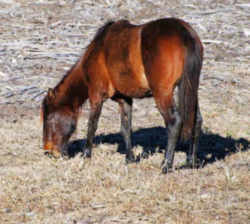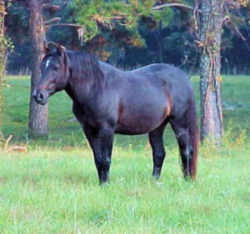
Florida Symbols
Florida State Horse
Cracker Horse (Marshtackie)

(E. f. caballus)
Adopted in 2008.
Florida designated the Florida cracker horse (or marsh tacky) as the official state horse in 2008 (expires July 1, 2018 unless renewed). Florida Cracker Horses are small saddle horses, standing from 13.2 hands to 15.2 at the withers and weighing 700 - 1000 pounds. The Florida Cracker is a gaited breed known for its agility and speed. Crackers have been used for trail, pleasure, reining, team roping, team penning, pulling wagons and always as working cow horses.
Florida State Horse: Cracker Horse (Marshtackie)

The Florida Cracker Horse is a breed of horse from Florida in the United States. It is genetically and physically similar to many other Spanish-style horses, especially those from the Spanish Colonial Horse group. The Florida Cracker is a gaited breed known for its agility and speed. The Spanish first brought horses to Florida with their expeditions in the early 1500s; as colonial settlement progressed, they used the horses for herding cattle. These horses developed into the Florida Cracker type seen today, and continued to be used by Florida cowboys (known as "crackers") until the 1930s.
Alternative names:
Chickasaw Pony, Seminole Pony, Prairie Pony, Florida Horse, Florida Cow Pony, Grass Gut
Appearance
Florida Cracker Horses are small saddle horses, standing from 13.2 hands to 15.2 at the withers and weighing 700 - 1000 pounds. The head is refined and intelligent in appearance. The profile is straight or slightly concave. The throat latch is prominent and the jaw is short and well defined. The eyes are keen with an alert expression and have reasonable width between them. The eye colors are dark, with a white sclera, gray or blue. The neck is well defined, fairly narrow, without excessive crest and is about the same length as the distance from the withers to the croup. The withers are pronounced but not prominent. The chest is medium to narrow in width with an inverted "V" formed between the two front legs. The shoulders are long and sloping with a 40 to 50 degree angle. A well laid back shoulder with smooth muscling is preferred. The back is short, narrow and strong with well sprung ribs. The point of the withers and the point of the croup are equal in height. The under line is longer than the top line. The croup is sloping and short and the tail is set medium low.
Colors are any of those known to the horse; however, solid colors and grays are most common.
While this external type is distinctive, breed proponents insist that the best way to tell a Cracker Horse is to ride one. The ground covering gaits found in these horses include the flatfoot walk, running walk, trot and ambling gaits. Cracker Horses are willing workers whose actions show spirit, amazing stamina and endurance.
History
In the 1800s, the horse became important to Florida ranching and agriculture, as it was well-suited to its unique environment and terrain. Florida cattlemen were referred to as "crackers"for the sound their whips made, hence the name. In the 1930s, larger cattle were transported to Florida from areas devastated by the Dust Bowl, which required roping and penning, and Cracker horses were replaced by larger quarter horses. By the late 1980s, only a few hundred remained. A concentrated effort by a few Florida families brought them back from the brink. Along with private herds, a few herds are maintained by the state. In 2009, there were 964 in the FCHA registry.
Characteristics
Florida Cracker horses are small saddle horses known for their stamina, intelligence, quickness, strength, and easy ride. They are spirited willing workers with a strong herding instinct and great agility over rough ground. A most distinctive attribute is their gait, which is described as an ambling, single-foot gait known as the "coon rack.
Current Status
The Florida Cracker Horse Association (FCHA) was formed in 1989 by cattlemen interested in protecting the breed from extinction. The FCHA Registry was created in 1991 and started with several "foundation horses"(horses of known ancestry from cracker lines of long standing). By the year 2000, the Registry included 130 foundation horses and 285 descendants.
At the start of 2009, there were 964 horses in the FCHA Registry, approximately 30 at Payne's Prairie, four mares and one stallion at the Agricultural Museum, and three mares and one stallion at Withlacoochee.
Although still used predominantly as working cattle horses, Crackers have been used for pulling wagons and farm implements, for penning, for reining, as pleasure and trail riding horses, and have served a wide variety of other functions. In addition, their agility, quickness, and easy ride have also made them popular in several types of equine events such as team penning, team roping, endurance riding, polocrosse, and others. In 2008, the Florida legislature officially designated the Cracker Horse as the State's Heritage Horse.
Florida Law
The law designating the Florida Cracker Horse (Marshtackie) as the official Florida state horse is found in The Florida Statutes, Title 4, Chapter 15, Section 15.0526.
CHAPTER 15
SECRETARY OF STATE
15.0526 Official state horse.-
(1) The Florida Cracker Horse (Marshtackie) is designated as the official Florida state horse.
(2) This section is repealed July 1, 2018, unless reviewed and reenacted by the Legislature before that date.
History.- s. 1, ch. 2008-34.
Taxonomic Hierarchy: Florida Cracker Horse (Marshtackie)
Kingdom: Animalia
Phylum: Chordata
Class: Mammalia
Order: Perissodactyla
Family: Equidae
Genus: Equus
Species: E. ferus
Subspecies: E. f. caballus







